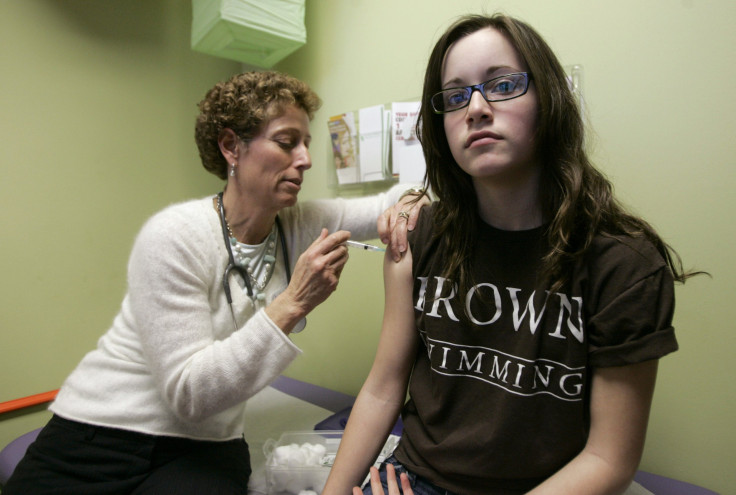Gardasil 9, The Newest HPV Vaccine, Projected To Prevent More Cervical Cancer Deaths And Lower Costs

Human papillomavirus (HPV) is the most common sexually transmitted infection in the United States. In 1983, scientists first published evidence showing HPV causes cervical cancer in women, and now it is also known to cause cancers of the anus, mouth/throat, and penis in men. Hoping to limit the spread of this noxious virus, American health authorities began recommending HPV vaccination in 2007 for all girls and women between the ages of 9 and 26, and in 2011 they extended this recommendation to boys and men between the ages of 11 and 21.
Despite these guidelines, vaccination rates across the country range from just 20 to 57 percent for the full coverage three doses of the vaccine provides among girls and 9 to 43 percent for full coverage among boys. A new study suggests that better coordination among the states and use of the newest HPV vaccine would significantly reduce both the number of cervical cancer cases and healthcare costs.
The current low vaccination rates have disappointed public health experts at the Centers for Disease Control and Prevention (CDC), who recognize that a variety of factors are likely to have stymied adoption of the new vaccine. The HPV vaccine is not a one-shot deal; it takes three doses spread out over about 8 months to protect against the virus known to cause cancer. Add to that the fact that many physicians are reluctant to recommend the vaccine due to parental concerns that immunization might encourage teens to have sex. Finally, some states have taken little or no action to promote vaccination, while others mandate vaccination as a prerequisite for school admission and permit local pharmacies to vaccinate children.
A national snapshot reveals many complexities, including one important additional factor: not all HPV strains are created equal. While scientists have identified more than 100 viral types, just two types, HPV-16 and HPV-18, are responsible for 66 percent of all cervical cancers, researchers at the CDC say. Two vaccines, Gardasil (2006) and Cervarix (2009), effectively shield against these two viral strains, yet do a less efficient a job of protecting against some of the other strains. Overall, these vaccines offer only 66 percent protection against cervical cancer.
In 2014, the Food and Drug Administration approved a new-and-improved HPV vaccine, Gardasil-9. Though it still requires three separate shots and costs slightly more than the existing vaccines ($13 to $18 more per dose, depending on your location), it provides 80 percent protection against cervical cancer.
For the current study, Dr. David Durham, Yale School of Public Health, and his colleagues at University of Waterloo wanted to know the impact of switching to the new vaccine. They began by developing a model of HPV transmission and cervical cancer incidence for individual states and for the U.S. as a whole.
When creating their model, they looked at many moving parts, including the separate strains of HPV, different sexual behaviors, and people migrating between states. After analysis of the data, Durham and his co-authors say each individual state would reduce cervical cancer incidence, deaths, and health costs, if every state switched to the new vaccine and coordinated their policies.
Specifically, their projections indicate the new vaccine would help to decrease the number of cervical cancer cases by 73 percent compared to 63 percent with the older vaccines, while also reducing deaths by 49 percent versus 43 percent. They also say it would take 11 percent more teens and young adults to begin using the older two vaccines to equal the health benefits of the new vaccine at the current (low) rates of coverage. Surprisingly, vaccinating an additional 11 percent more people with the older, less expensive (and less effective) vaccines would also cost $2.7 billion more than vaccinating the current number of people with the newer, more expensive shot.
Durham and his colleagues say that “expanding coverage in U.S. states with the lowest coverage will be much more effective in reducing nationwide cervical cancer compared to expanding coverage in states with the highest coverage.” They also suggest states adopt multi-pronged strategies combining cancer and vaccination initiatives, public outreach, and physician training, while allowing pharmacists to immunize teens and young adults.
Source: Durham D, Ndeffo Mbah ML, Skrip LA, et al. The national and state level impact and cost-effectiveness of nonavalent HPV vaccination in the US. Proceedings of the National Academy of Sciences. 2016.
Published by Medicaldaily.com



























